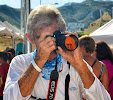
This chart reflects the warmer water caused by the El Niño.
Over the years the usual response to almost anything unusual occurring on or in the waters off Baja and southern California has been to blame it on El Niño…so it’s easy to understand why some of our eyes glaze over when El Niño is mentioned.
The name El Niño comes from the Spanish name for "the little boy”, but it can also refer to the Christ Child. It is so named because when the phenomenon of an El Niño happens, it is normally around Christmas time. Its full name is El Niño-Southern Oscillation (ENSO) but it is more commonly referred to as just El Niño. This global ocean-atmosphere phenomenon usually happens in the Pacific Ocean off the west coast of South America when warm water spreads from the west Pacific and the Indian Ocean to the east Pacific.
At the recent, well-attended Long Beach Fred Hall show, the crowded aisles left some attendees feeling like a single sardine in a tightly formed bait ball. The entire Baja peninsula was well represented providing an ideal opportunity to review the waning winter and the expectations for the upcoming season as I visited with old and new friends.
Optimism and glowing reports of extraordinary fishing were a common theme in most booths and areas of the show where display tables were covered with photos and piled high with brochures and the ever-present televisions playing endlessly. Baja sunlight with fish of every imaginable description leaped about on the screen providing a barrier that protected the booths’ occupants.
Last summer it was predicted that El Niño would return for the winter season of 2009-2010. Of course last year's weather with eighteen named storms could not be ignored. Baja's mid-section suffered the brunt of their fury and is still struggling to return to normalcy. But the resiliency and courage to recover by both American and Mexican locals alike was reflected on my last few trips through that area in late 2009.
On the west coast of Baja, beginning just below the border and continuing all the way to Abreojos, the stories of mossback yellows was confirmed by Pat McDonell, WON Editor on his trip to the Coronado Islands. Farther down the Baja coast near Colonet, a few of the San Diego fleet boats reported good catches of reds and yellows, and the yellows were found by locals and trailer boaters still farther down the peninsula at San Quintin and Bahia Asuncion.
A constant stream of emails from Mulege about the great yellowtail, roosterfish and snook fishing continued throughout the winter but was overshadowed by the catch of a marlin putting an exclamation point on their unusual winter season.
Brandon Hayward, Saltwater Editor in the Western Outdoor News’ booth, was selling the third printing of his successful book, The Southern California Angler. Brandon was very excited about the yellowtail action that John Mestrin of Bluewater Tours had introduced him to down Loreto way. Another marlin landed at Loreto seems to confirm the sea temperatures are unseasonably warm.
Farther down the coast at La Paz, Jonathan and Jill Roldan's weekly Tailhunter Reports have confirmed that many of the fish usually associated with warmer water have remained in the area. Recently he commented, "the variety (of fish) we have had makes us wonder about the El Niño everyone says is upon us."
Not to be outdone, the inshore and beach fishing at East Cape has produced quality-sized jacks and roosterfish throughout the winter, while the larger grade of yellowfin tuna were still being caught offshore in early January at San Jose del Cabo.
According to Tim Barnett, Scripps Research Marine Physicist, the higher water temps are due to El Niño. During these events whole populations are shifted northward to keep up with their favorite temps. Scripps computer model which has done a great job predicting this event predicts that the effects should be completely gone by June.
The two fisheries that under-performed this winter was the striped marlin bite at the Golden Gate Bank and the dismal blue marlin bite which had occurred for the past few years.
However, the consensus of the Baja exhibitors at Fred Hall was that the excellent fishing enjoyed throughout the winter would continue through the upcoming spring and summer season and would be memorable, but quién sabe? To follow the progress of the El Niño go to this link: http://tiny.cc/elnino2010
